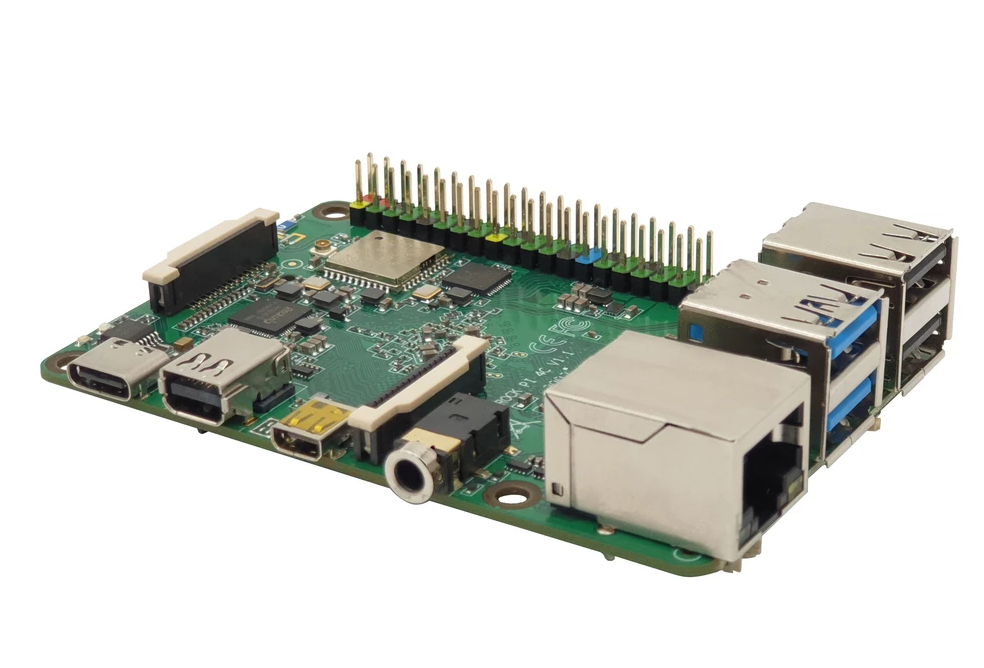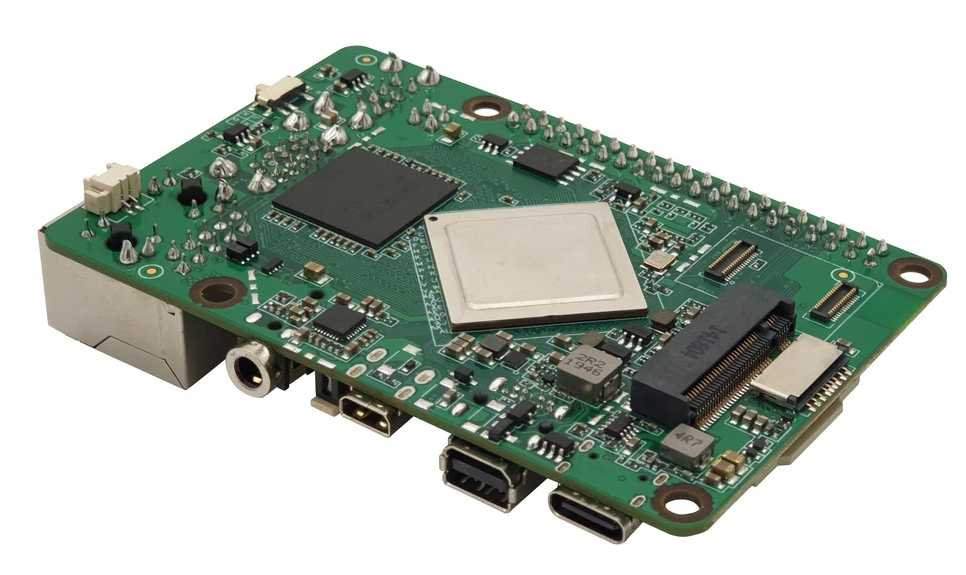Rock Pi 4 Model C: NVMe and eMMC in a Raspberry Pi Layout
It looks like a Raspberry Pi but this board has something more to offer.

Originally announced in October 2019, Rock Pi 4 Model C from Radxa has been unavailable for purchase until now. CNX Software have keenly spotted that the Rock Pi 4 Model C is now available from $59. Rock Pi 4 Model C is a design hybrid, measuring 3.3 x 2.1 inch (85 x 54 mm) this board shares layout cues from the Raspberry Pi 3 and 4 but it has a little more to it than a Raspberry Pi.
Rock Pi 4C Specifications
- SoC – Rockchip RK3399 big.LITTLE hexa-core processor with
- CPU: 2x Arm Cortex-A72 @ up to 1.8 GHz, 4x Cortex-A53 @ up to 1.4 GHz
- GPU: Mali-T864 with support OpenGL ES1.1/2.0/3.0/3.1/3.2, Vulkan 1.0, OpenVG1.1, OpenCL 1.1/1.2, DX11, and AFBC
- VPU with 4K VP9 and 4K 10-bit H265/H264 decoding
- 64-bit 4GB LPDDR4 @ 3200 Mbps (single chip)
- eMMC module socket up to 128GB
- Micro SD card slot up to 2TB
- 4-lane M.2 NVMe SSD socket (expansion board required)
- Micro HDMI 2.0a up to 4K @ 60 Hz
- Mini DP 1.2 up to 2560 x 1440 @ 60 Hz
- Audio – Via HDMI and 3.5mm audio jack
- Camera – MIPI-CSI2 connector for camera up to 8MP
- Connectivity – Gigabit Ethernet with PoE support (add on required), dual-band 802.11b/g/n/ac WiFi 5, Bluetooth 5.0 with on-board antenna
- USB – 1x USB 3.0 host port, 1x USB 3.0 OTG port, 2x USB 2.0 host ports
- Expansion – 40-pin I/O header with 1x UART, 2x SPI bus, 2x I2C bus, 1x PCM/I2S, 1x SPDIF, 1x PWM, 1x ADC, 6x GPIO, and power signals (5V, 3.3V, and GND)
- Misc – RTC with connector for backup battery
- Power Supply – Via USB-C port supporting USB PD 2.0 (9V/2A, 12V/2A, 15V/2A, or 20V/2A) and Qualcomm Quick Charge 3.0/.0 (9V/2A, 12V/1.5A)

The Rockchip RK3399 hexa-core processor features a dual core Arm Cortex A72 1.8GHz, the same A72 CPU as found in the Raspberry Pi 4, but the Raspberry Pi has a quad core CPU running at 1.5GHz, so with less cores but more speed will there be much difference in performance? We will need to get a hold of a unit for test!
There are dual display outputs, micro HDMI and mini DisplayPort providing 4K @ 60Hz and 2560 x 1440 @ 60Hz respectively. Connectivity comes in the form of four USB ports, two USB 3.0, two USB2.0 and Gigabit Ethernet, so Raspberry Pi 4 connections, in a Raspberry Pi 3 layout. Wireless connectivity is 802.11 b/g/n/ac WiFi 5 and Bluetooth 5.0 via an on-board antenna, but there is an external antenna connection. A 40 pin GPIO is present, providing access to UART, SPI, I2C, PCM /I2S, SPDIF, PWM and an Analog to Digital Converter, something not found on the Raspberry Pi GPIO.
What is different about the Rock Pi 4 Model C is storage. Sure we have the usual microSD card slot, but we also have an eMMC socket which can be used with up to 128GB modules, purchased separately. There is also a four lane M.2 NVMe socket that is used with an expansion board to bring NVMe storage. Much faster and more reliable than microSD cards.
We can't wait to get one of these on our bench for testing.
Get Tom's Hardware's best news and in-depth reviews, straight to your inbox.

Les Pounder is an associate editor at Tom's Hardware. He is a creative technologist and for seven years has created projects to educate and inspire minds both young and old. He has worked with the Raspberry Pi Foundation to write and deliver their teacher training program "Picademy".
-
bit_user Cool, but I'm getting a little bored with RK3399. Those run kinda hot, as well.Reply
NVMe makes sense from a form factor perspective, but you'd be hard-pressed to see a performance difference between it and a decent SATA SSD. That CPU is too much of a bottleneck. -
CooliPi Interesting board. But Raspberry Pi 4 can be easily overclocked, the worst unit I had was OK upto 1750MHz, the other upto 1850MHz and the third one (I'm using as a desktop now) runs at 2GHz flawlessly.Reply
Some people swear that placing the CPU on the bottom of the board is the right way of cooling it down, because the upper side can be left for expansion boards. True, but the heat must get out of the bottom of the board anyway, and with that laying on a table, it's easily blocked by the board itself. In industrial environments it's easier as the board including a heatsink may be mounted upside down or in any position.
I'm glad Raspberry Pi 4 has all the power hungry chips at the top, because I can get rid of the heat easily - dissipate it all upwards passively.
And about the new interfaces - I agree that 4 lane NVMe is a bit overkill, because the bottleneck would certainly be somewhere else - in the gigE for example. DisplayPort - certainly nice. The biggest feature I see is the VPU with hardware decoding of multiple video formats - perhaps yet to come to the future Raspberry Pi. But don't forget software, if it ain't gonna work out of the box, it's useless.
I was dreaming about multiple SATA ports for my Pi, but with some external bridges running over USB3, it's doable. The biggest peculiarity I'm always scared of is the handling of disk errors by usb to sata bridges. But with UASP protocol, it may be a scare of the past. There's hope in this article
https://www.tomshardware.com/news/faster-usb-disk-io-for-raspberry-pi
for us, NAS eager users - maybe the UASP protocol handles all the errors, maybe even S.M.A.R.T. transparently? I seriously don't know, If you do, please respond. If you do know of the best USB3 <-> SATA bridge without quirks, report it, please. I'm looking for a decent SATA bridge from the beginning of the Raspberry Pi usage.
Some bridges worth mentioning:
Geekworm Raspberry Pi 4 SATA Storage
Radxa’s Dual and Quad SATA HATshttp://linuxgizmos.com/sata-hats-support-up-to-four-drives-on-raspberry-pi-4-or-rock-pi-4/
The latter has JMicron JMS561 bridge. I don't know if it's blacklisted by the Linux kernel (for having some bugs) or not. If you have personal experience, please report it.
I'm interested in a controller, that can be used in UASP mode/protocol. -
CooliPi Reading the kernel source fileReply
https://github.com/raspberrypi/linux/blob/rpi-5.7.y/drivers/usb/storage/unusual_uas.h
, I'm scared some more that choosing the right bridge would be very frustrating. The US_FL_BROKEN_FUA, US_FL_IGNORE_UAS masks are plentiful there. And one doesn't know it it's ok with the rest of the controllers, or just not yet reported.
So any personal success report is gladly welcome.